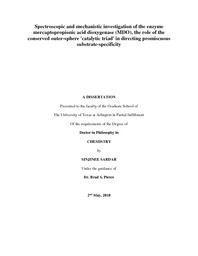
ATTENTION: The works hosted here are being migrated to a new repository that will consolidate resources, improve discoverability, and better show UTA's research impact on the global community. We will update authors as the migration progresses. Please see MavMatrix for more information.
Show simple item record
| dc.contributor.advisor | Pierce, Brad | |
| dc.creator | Sardar, Sinjinee | |
| dc.date.accessioned | 2018-06-05T18:52:00Z | |
| dc.date.available | 2018-06-05T18:52:00Z | |
| dc.date.created | 2018-05 | |
| dc.date.issued | 2018-05-16 | |
| dc.date.submitted | May 2018 | |
| dc.identifier.uri | http://hdl.handle.net/10106/27471 | |
| dc.description.abstract | Mercaptopropionate dioxygenase (MDO) from Aztobacter Vinelandii is a non-heme mononuclear iron enzyme that catalyzes the oxygen dependent conversion of 3-mercaptopropionic acid (3mpa) to produce 3-sulfinopropinioic acid (3spa). Nearly, all thiol dioxygenases have a conserved ‘catalytic triad’ within the active site, consisting of three outer Fe-coordination sphere residues S155, H157 and Y159. With the notable exception of mammalian cysteamine (2-aminoethanethiol) dioxygenase (ADO), this ‘catalytic triad’ is universally conserved across phylogenic domains. X-ray crystallographic studies clearly show a hydrogen bond network connecting the ‘catalytic triad’ to the mononuclear iron site; however, its influence on substrate specificity and catalytic efficiency is poorly understood. In this work, kinetic and spectroscopic characterization of AvMDO is presented, focusing especially on the role of the conserved ‘catalytic triad’ on enzyme catalysis. In addition, pH/pD-dependent to solvent kinetic isotope (SKIE) experiments and proton inventory experiments were performed to investigate rate limiting proton-dependent steps during catalysis. Complementary viscosity studies are presented to probe diffusion limited steps in steady-state reactions.
Comparative studies were performed for reactions with L-cysteine and 3mpa as a substrate, for the active site variants, H157N and Y159F to investigate the role of specific residues within the ‘catalytic triad’. Taken together with supporting EPR and Mössbauer spectroscopic studies, a mechanistic model is proposed in which the ‘catalytic triad’ serves to gate proton delivery to the substrate-bound Fe-site. These studies suggest that the primary role of the ‘catalytic triad’ is to neutralize the negative charge of the substrate-carboxylate group in the rate-limiting non-chemical steps leading up to O2-activation. | |
| dc.format.mimetype | application/pdf | |
| dc.language.iso | en_US | |
| dc.subject | Enzyme | |
| dc.subject | Enzyme kinetics | |
| dc.subject | Dioxygenase enzymes | |
| dc.subject | MDO | |
| dc.subject | Mercaptopropionate dioxygenase | |
| dc.title | Spectroscopic and mechanistic investigation of the enzyme mercaptopropionic acid dioxygenase (MDO), the role of the conserved outer-sphere 'catalytic triad' in directing promiscuous substrate-specificity | |
| dc.type | Thesis | |
| dc.contributor.committeeMember | Heo, Jongyun | |
| dc.degree.department | Chemistry and Biochemistry | |
| dc.degree.name | Doctor of Philosophy in Chemistry | |
| dc.date.updated | 2018-06-05T18:54:07Z | |
| thesis.degree.department | Chemistry and Biochemistry | |
| thesis.degree.grantor | The University of Texas at Arlington | |
| thesis.degree.level | Doctoral | |
| thesis.degree.name | Doctor of Philosophy in Chemistry | |
| dc.type.material | text | |
Files in this item
- Name:
- SARDAR-DISSERTATION-2018.pdf
- Size:
- 3.854Mb
- Format:
- PDF
This item appears in the following Collection(s)
Show simple item record


